The Future of Agriculture Expanding from Wakamatsu
Taking on new agricultural challenges
Feature PICK UP 未来を創る新産業 若松を興す
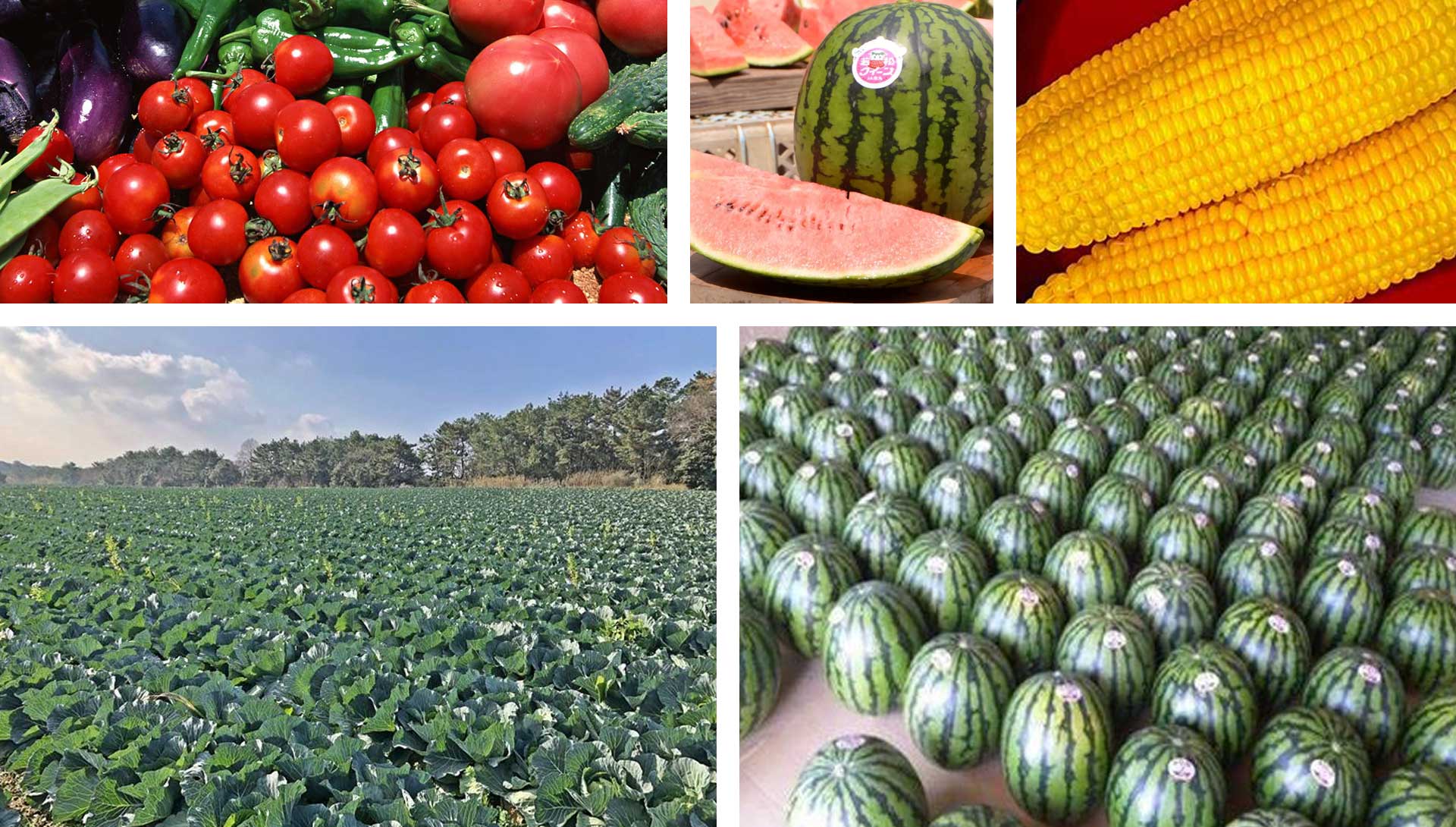
— Current Status of Kitakyushu City and Fukuoka City by Indicators
Once known as the “Fukuoka-Kitakyushu Metropolitan Area,” Fukuoka City and Kitakyushu City competed as Kyushu’s leading cities. However, since the 2000s, the gap between them has widened in terms of population dynamics and urban strength. Compared to Fukuoka City, which rivals Tokyo and Osaka in population growth, economic strength, and domestic/international attention, Kitakyushu City faces declining birthrates, an aging population, and population loss. Its population fell below 1 million in 2005 and is projected to drop below 800,000 in 20 years.
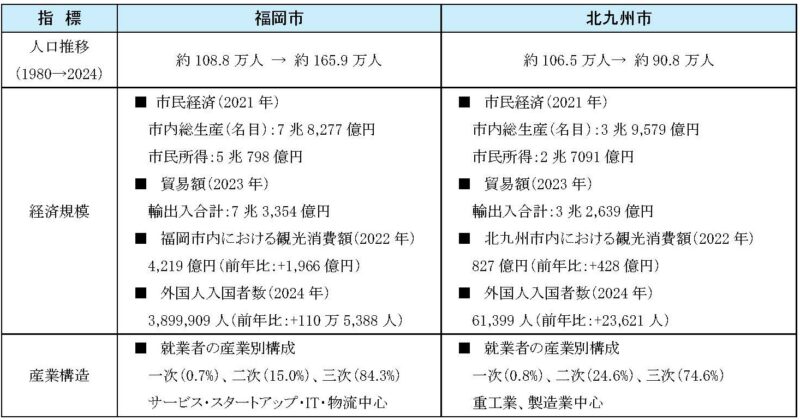
Amidst this, Kitakyushu City’s most pressing challenge is industrial innovation to attract young people. It must leverage its manufacturing-honed “monozukuri capabilities” as a foundation, incorporate growth sectors like environment, renewable energy, and food/agriculture, while implementing policies to enhance flexible work styles and the appeal of local life.

— The Strength of Agriculture as “Manufacturing”
Viewing Kitakyushu’s agriculture specifically through a manufacturing lens reveals a high proportion of field crops like vegetables and horticultural products (for processing and local distribution). This structure provides the strength to supply agricultural products in large quantities and with rapid turnaround directly from production sites. Furthermore, efforts are underway to maintain production by small and medium-sized farms, attract young people through income growth and community connections.
Over 2,000 farming households cultivate vegetables, rice, flowers, and fruit trees, with leafy greens accounting for over 60% of production. Bamboo shoots, shungiku, Chinese cabbage, and spinach are widely recognized. While Kitakyushu City lags behind Fukuoka City in agricultural output value which focuses on livestock and high-value-added vegetables it is investing in smart agriculture to promote agritourism and increase profitability for small-scale farming.
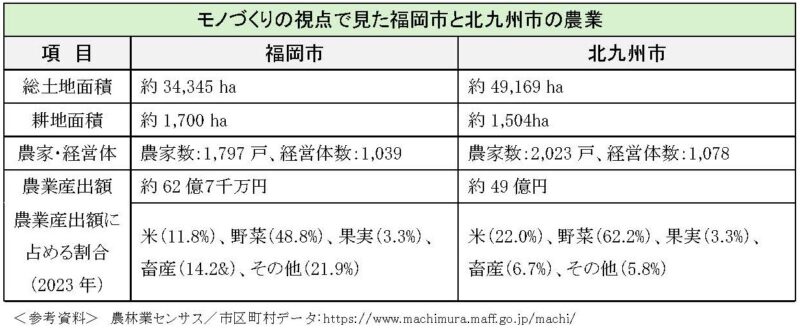
— The Growing Appeal of the Wakamatsu Brand
While Kitakyushu’s agriculture is primarily suburban, Wakamatsu Ward, blessed with sea and greenery, utilizes its vast plateaus and breezy climate for vegetable cultivation. “Wakamatsu Sea Breeze Cabbage,” grown in fields near the coast influenced by sea winds, has been branded for its superior flavor and quality. The area boasts many popular specialties like Wakamatsu Queen (small watermelon), Wakamatsu Water-Drain Tomatoes, and Takakura Loquats.

urthermore, the district is introducing smart agriculture utilizing cutting-edge technologies like AI (Artificial Intelligence) and IoT (Internet of Things). This approach aims to enhance farmer productivity, streamline operations, and improve quality control, tackling challenges such as stabilizing yields and addressing the shortage of agricultural workers.
At Hibikinada Vegetable Garden, jointly established by Kagome and Electric Power Development in 2005, large-scale high-tech greenhouses enable year-round cultivation of fresh tomatoes, stably supplying approximately 3,000 tons of various tomato varieties annually. To minimize quality variation, nutrient-rich water is used in “hydroponic cultivation,” and the tomato-friendly environment is controlled by computers.
Environmentally friendly LP gas is used as a heat source to maintain the ideal temperature for cultivation, and the CO2 generated during combustion is captured and effectively utilized for the photosynthesis necessary for tomato growth. To reduce the use of pesticides, microbial control agents and electrolyzed water are used, promoting agriculture that coexists with living organisms.
These advanced cultivation methods are also used by Energy Greenhouse Co., Ltd., which mass-produces pesticide-free hydroponic lettuce in the Hibikinada area. Lettuce grown in computer-controlled nutrient solutions without soil is not affected by the climate and is systematically produced and shipped throughout the year.
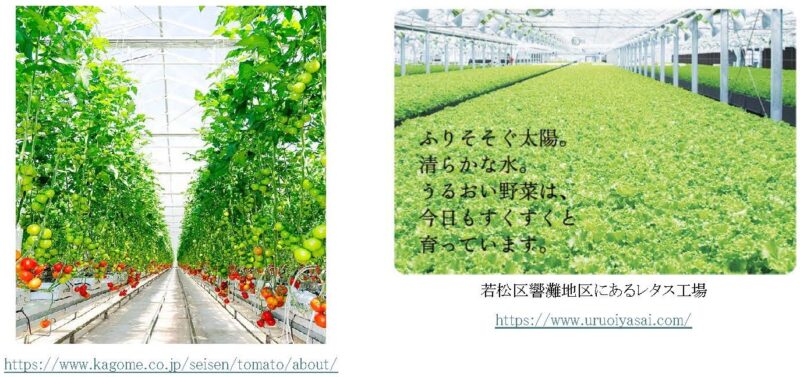
— A new attraction combining agriculture and tourism
Facilities offering agricultural experiences in Wakamatsu Ward are concentrated in the North Coast area. Representative farms include Nature, where visitors can enjoy tomato picking and cultivation experiences; Matsuura Farm, where seasonal vegetable harvesting experiences are available; Agri Resort, a membership-based farm where everyone shares vegetables they want their children to eat; Tanaka Farm, known for its homemade fruit blend soft serve ice cream; and Tenshoen, where visitors can pick mikan oranges.
The North Coast area is rich in nature and surprises, including Green Park, which attracts 500,000 visitors a year, the Tonda Reservoir, which holds 9 million tons of water, offshore wind turbines lining the coastline, sunsets painting the horizon, the Tomihana Lighthouse, ancient fossils, and more. In this area rich in nature and surprises, agritourism is booming, offering visitors the chance to enjoy farming experiences, local nature, culture, and interaction with the people.
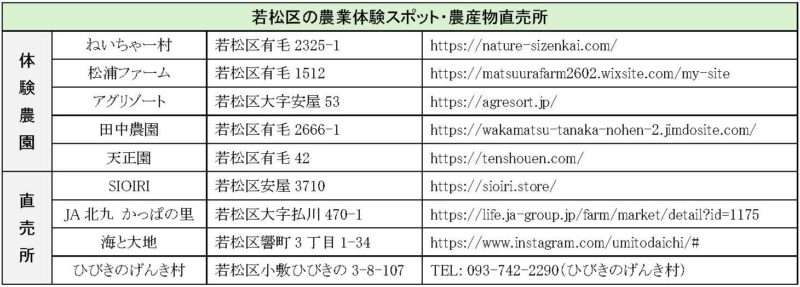
Nature Village: https://nature-sizenkai.com/
Matsuura Farm: https://matsuurafarm2602.wixsite.com/my-site
Agresort: https://agresort.jp/
— The Future of Agriculture Pioneered by Industry-Academia-Government Collaboration
Kitakyushu City is collaborating with local universities and businesses to develop environmentally conscious agricultural technologies and advance the sixth industrialization of agriculture. This initiative encourages agricultural producers themselves to engage in “Primary Industry (Production) × Secondary Industry (Processing) × Tertiary Industry (Sales/Services)” to increase their income. Hop producers, breweries, retailers, related companies, citizens, and the city government within Kitakyushu have joined forces to form the “Hibiki-nada Hop Association.” Since 2020, they have begun manufacturing and selling the craft beer “Hibiki Fresh Hops Wakamatsu Ale,” and product development using Wakamatsu-grown hops is progressing
Hibikinada Hop Association:https://www.hibikifreshhops.com/
Furthermore, to address the aging agricultural workforce and labor shortages, initiatives such as smart agriculture for workforce development, new farmer support programs, and agriculture-welfare partnerships are being implemented. This establishes a framework enabling diverse entities to participate in agriculture.
These agricultural revitalization efforts represent a key solution for regions facing aging populations and population decline. Wakamatsu Wards challenge to enhance the appeal and accessibility of agriculture has become a key factor in the revival of Kitakyushu City.








